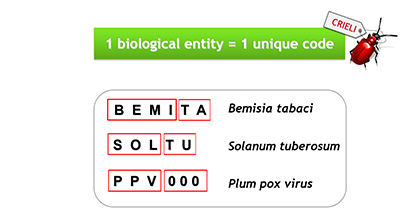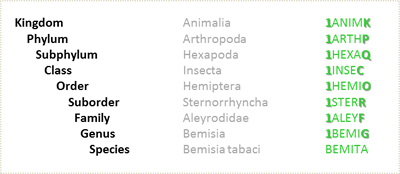
EPPO codes
What are the EPPO codes?
- EPPO codes are computer codes developed for plants, pests (including pathogens) which are important in agriculture and plant protection.
- EPPO codes constitute a harmonized coding system which aims to facilitate the management of plant and pest names in computerized databases, as well as data exchange between IT systems.
- EPPO codes can be freely downloaded and incorporated into other IT systems.
EPPO Codes Users Monthly Newsletter
To be informed about the main modifications that are made to the coding system (new codes and deactivated codes):
A brief history
The development of this coding system was initiated by BAYER in the 1970s. In 1996, BAYER transferred to EPPO the maintenance and development of the coding system. During the 1990s/2000s, EPPO developed a dedicated interface in order to facilitate access to the codes and their associated names, which was called the EPPO Plant Protection Thesaurus (EPPT). In 2007, it was agreed to rename BAYER codes as EPPO codes. In 2014, a new web-based database (EPPO Global Database) was launched to replace EPPT.
Since 2014, EPPO codes can be:
- consulted via the EPPO Global Database,
- downloaded via a dedicated platform, the EPPO Data Services.
General coding principles
 How EPPO codes are constructed?
How EPPO codes are constructed?
EPPO codes are constructed with combinations of 5 to 6 letters and, whenever possible, codes are mnemonic abbreviations of the scientific name of the organism.
- Each taxon is represented by a unique code
- Pests and pathogens: 6 letters = 4 (genus) + 2 (species)
- Cultivated and wild plants: 5 letters = 3 (genus) + 2 (species)
- Viruses and virus-like organisms: 6 letters = acronym whenever possible
EPPO codes are provided for the main steps of the taxonomic tree and coding has been harmonized for each level (e.g. all codes for families starts with 1 and ends with F). In addition, parent/child relationships have been created between each taxonomic level.

How taxonomic changes are managed?
When for taxonomic reasons a scientific name is changed, the EPPO code remains the same.
- For example, the EPPO code GNORAB was created for the tomato leafminer when this pest was called Gnorimoschema absoluta. When its name was changed into Tuta absoluta, the code remained unchanged in the database but the associated preferred scientific name was changed into Tuta absoluta. In addition, the link (parent/child relationships) existing between the species concerned and the genus to which it belongs was updated accordingly [i.e. the species code GNORAB was linked to the genus code 1TUTAG (code for the genus Tuta), instead of the genus code 1GNORG (code for the genus Gnorimoschema)].
- When new species are described, new codes can be created. For example, when Phytophthora pinifolia was described as a new Phytophthora species, a new code (PHYTPF) was created.
Current contents
EPPO codes have been created for more than 98 500 species (as of June 2025) that are important in agriculture and plant protection. Every year, many new codes are created (on average 4000 new codes) and revisions are made to names or taxonomic elements. In addition to taxa, the database also contains a smaller set of codes describing non-taxonomic entities that are of interest to those working in the field of plant protection products (e.g. crop groups, targets, treatments).
- 59 000 plant species (cultivated, wild, weeds)
- 27 500 animal species (e.g. insects, mites, nematodes, rodents), biocontrol agents
- 12 000 microorganism species (e.g. bacteria, phytoplasmas, fungus, viruses, viroids and virus-like)
- 625 non-taxonomic entities (e.g. crop groups)
For each organism, the database provides:
- A unique EPPO code
- The preferred scientific name and authority
- Synonyms and other scientific names
- Common names in different languages
- Elements of taxonomy
How to download and use the EPPO codes into other IT systems?
EPPO codes are freely available under the terms of an open data licence. New web services are being developed to facilitate the downloading of EPPO codes so that they can be used in other IT systems. Computer files (in different formats), the open data licence, and more explanations can be found in the EPPO Data Portal.
How to request new EPPO codes to be created?
The EPPO Secretariat continues to create new codes and this service is still subject to fees. Prices, modes of payment and all other necessary tools to request new codes for taxa that are not yet included in the coding system are available via EPPO Global Database (download a practical guide ![]() ).
).
For non-taxonomic entities (e.g. crop groups, pest groups) that are of particular interest to the plant protection products sector, it has been agreed that new codes will be created under the supervision of the EPPO Expert Working Group on harmonization of data on plant protection products and EPPO codes. Read more details on this harmonized classification on the dedicated webpage. Requests concerning non-taxonomic entities can be sent to the EPPO Secretariat by email (hq@eppo.int).
Useful references
- General presentation on EPPO codes made at the webinar for EPPO codes users (Paris, 2025-12-08).
- Brief description of the EPPO codes
